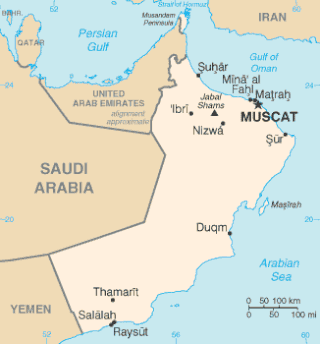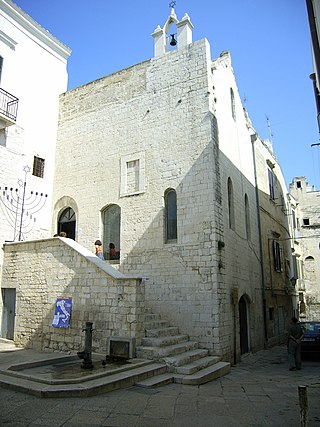Related Research Articles

Benevento is a city and comune of Campania, Italy, capital of the province of Benevento, 50 kilometres (31 mi) northeast of Naples. It is situated on a hill 130 metres above sea level at the confluence of the Calore Irpino and the Sabato. In 2020, Benevento has 58,418 inhabitants. It is also the seat of a Catholic archbishop.
This article lists expulsions, refugee crises and other forms of displacement that have affected Jews.

The Duchy of Benevento was the southernmost Lombard duchy in the Italian Peninsula that was centred on Benevento, a city in Southern Italy. Lombard dukes ruled Benevento from 571 to 1077, when it was conquered by the Normans for four years before it was given to the Pope. Being cut off from the rest of the Lombard possessions by the papal Duchy of Rome, Benevento was practically independent from the start. Only during the reigns of Grimoald and the kings from Liutprand on was the duchy closely tied to the Kingdom of the Lombards. After the fall of the kingdom in 774, the duchy became the sole Lombard territory which continued to exist as a rump state, maintaining its de facto independence for nearly 300 years, although it was divided after 849. Benevento dwindled in size in the early 11th century, and was completely captured by the Norman Robert Guiscard in 1053.

The Duchy of Gaeta was an early medieval state centered on the coastal South Italian city of Gaeta. It began in the early ninth century as the local community began to grow autonomous as Byzantine power lagged in the Mediterranean and the peninsula due to Lombard and Saracen incursions.

The Duchy of Amalfi or the Republic of Amalfi was a de facto independent state centered on the Southern Italian city of Amalfi during the 10th and 11th centuries. The city and its territory were originally part of the larger ducatus Neapolitanus, governed by a patrician, but it extracted itself from Byzantine vassalage and first elected a duke in 958.

The Duchy of Naples began as a Byzantine province that was constituted in the seventh century, in the reduced coastal lands that the Lombards had not conquered during their invasion of Italy in the sixth century. It was governed by a military commander (dux), and rapidly became a de facto independent state, lasting more than five centuries during the Early and High Middle Ages. Naples remains a significant metropolitan city in present-day Italy.

Ahimaaz ben Paltiel was a Graeco-Italian liturgical poet and author of a family chronicle. Very little is known about his life. He came from a family some of whose members are well known in Jewish literature as scholars and poets; for example, Shefatya ben Amitai, Hananiel ben Amittai, and his nephew Amittai ben Shephatiah. Ahimaaz had two sons, Paltiel and Samuel. The family tree of this clan is given by Ahimaaz in his Chronicle:
Sergius I was the first duke of Naples of his dynasty, often dubbed the "Sergi," which ruled over Naples for almost three centuries from his accession in 840 until the death of his namesake Sergius VII in 1137.

The Principality of Capua was a Lombard state centred on Capua in Southern Italy, usually de facto independent, but under the varying suzerainty of Holy Roman and Eastern Roman Empires. It was originally a gastaldate, then a county, within the principality of Salerno.

The history of the Jews in Albania dates back about 2,000 years. According to historian Apostol Kotani : "Jews may have first arrived in Albania as early as 70 C.E. as captives on Roman ships that washed up on the country's southern shores...descendants of these captives that would build the first synagogue in the southern port city of Sarandë in the fifth century...[but] Little is known about the Jewish community in the area until the 15th century."

In the Jewish diaspora, a Jewish quarter is the area of a city traditionally inhabited by Jews. Jewish quarters, like the Jewish ghettos in Europe, were often the outgrowths of segregated ghettos instituted by the surrounding Christian authorities. A Yiddish term for a Jewish quarter or neighborhood is "Di yiddishe gas", or "The Jewish quarter." While in Ladino, they are known as maalé yahudí, meaning "The Jewish quarter".

There was a Jewish presence in Oman for many centuries, however, the Jewish community of the country is no longer in existence.

The Norman conquest of southern Italy lasted from 999 to 1139, involving many battles and independent conquerors.

The history of the Jews in Naples deals with the presence of Jews in the city of Naples, Italy. The Jewish presence in the city goes back at least 2,000 years. Today, the Jewish community in Naples numbers around 200 people.

The history of the Jews in Calabria reaches back over two millennia. Calabria is at the very south of the Italian peninsula, to which it is connected by the Monte Pollino massif, while on the east, south and west it is surrounded by the Ionian and Tyrrhenian seas. Jews have had a presence in Calabria for at least 1600 years and possibly as much as 2300 years. Calabrian Jews have had notable influence on many areas of Jewish life and culture. The Jews of Calabria are virtually identical to the neighbouring Jews of Sicily but are considered separate. However, the Jews of Calabria and the Jews of Apulia are historically the same community, only today are considered separate. Occasionally, there is confusion with the southern Jewish community in Calabria and the northern Jewish community in Reggio Emilia. Both communities have always been entirely separate.
The history of the Jews in Sicily potentially begins as far back as two millennia, with a substantial Jewish presence on the southern Italian island before their expulsion in the fifteenth century.

The history of the Jews in Apulia can be traced back over two thousand years. Apulia in Hebrew:פוליה) is a region in the "heel of the boot" of the peninsula of Italy bordering the Adriatic Sea. The Jews have had a presence in Apulia for at least 2000 years. The Jews of Apulia had a rich Rabbinic tradition and also had a sizeable Jewish population in the central Mediterranean prior to their expulsion.
References
- ↑ www.turismomatera.it [ permanent dead link ]
- ↑ Kreutz 1996, pp. 63–66, 68.
- ↑ www.jewishvirtuallibrary.org
- ↑ google.com/books
- ↑ bcrfj.revues.org
- ↑ www.italythisway.com
- ↑ www.jewishvirtuallibrary.org
- ↑ "The Jewish Community of Benevento". The Museum of the Jewish People at Beit Hatfutsot.
- ↑ www.jewishvirtuallibrary.org
- ↑ "The Jewish Community of Capua". The Museum of the Jewish People at Beit Hatfutsot.
- ↑ www.jewishvirtuallibrary.org
- ↑ www.jewishvirtuallibrary.org
- ↑ "www.prophecyinthenews.com". Archived from the original on 2011-07-22. Retrieved 2011-05-05.
- ↑ www.jewishvirtuallibrary.org
- ↑ www.italyworldclub.com